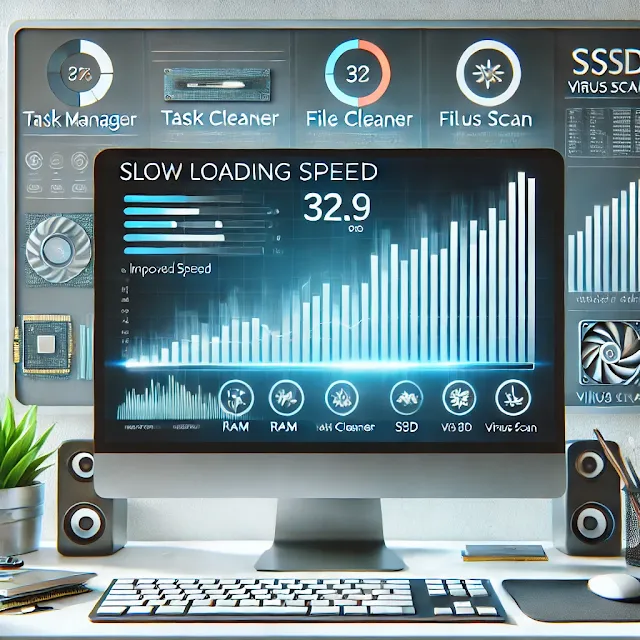How to Solve PC Slow Response: 10 Easy Ways to Speed Up Your Computer
Introduction
Is your PC running slower than usual? Waiting for programs to load or files to open can be frustrating, especially when you need to get work done. Over time, your computer’s performance can degrade due to various reasons such as too many background processes, lack of maintenance, or even malware infections. The good news is that you don’t need to be a tech expert to fix a slow computer! In this guide, we’ll show you 10 easy ways to solve PC slow response and get your machine back up to speed.
1. **Restart Your PC**
One of the simplest solutions to a slow PC is restarting it. If you haven’t turned off your computer in a while, a reboot can close unnecessary processes, clear temporary files, and refresh system resources. It’s a quick fix that can immediately improve performance.
Steps to Restart:
- Click the Start button.
- Select **Power** and then **Restart**.
- Wait for your PC to reboot and check if the performance improves.
2. **Check for Background Programs**
Background processes and programs can take up a significant amount of your computer’s resources, slowing down response times. Use the **Task Manager** to see which programs are consuming CPU, memory, or disk resources.
How to Check and Close Background Programs:
1. Press **Ctrl + Shift + Esc** to open Task Manager.
2. Look for programs using high percentages of CPU or memory.
3. Right-click the program and select **End Task** to close it.
---
3. **Free Up Hard Drive Space**
A full hard drive can seriously slow down your computer’s performance. Make sure you have at least 15-20% of your storage free for optimal operation. You can delete unnecessary files, clear the recycle bin, or use tools like Disk Cleanup to free up space.
Steps to Clean Up Disk Space:
1. Open File Explorer
2. Right-click your **C: drive** and select **Properties**.
3. Click **Disk Cleanup** and follow the instructions to remove junk files.
4. **Update Software and Drivers**
Outdated software or drivers can lead to compatibility issues, bugs, and performance bottlenecks. Ensure that your **Windows operating system** and all drivers are up-to-date to avoid any slowdowns.
How to Update Windows:
1. Go to Settings Update & Security
2. Click Check for updates and install any available updates.
3. Restart your PC to apply the updates.
For driver updates, you can use Device Manager or manufacturer-specific software.
5. **Remove Malware and Viruses**
Viruses, malware, or spyware can significantly reduce your computer’s performance by running malicious tasks in the background. Regularly scanning your computer with ,Windows Defender or a reliable third-party antivirus program is crucial for keeping your PC fast and secure.
How to Scan for Malware:
1. Open,Windows Security.
2. Go to,Virus & threat protection and select,Quick Scan
3. If issues are detected, follow the prompts to remove them.
6. **Disable Startup Programs**
Many applications automatically start when you boot up your PC, even if you don’t use them. Disabling unnecessary startup programs can greatly reduce your PC's boot time and speed up overall performance.
How to Disable Startup Programs:
1. Press,Ctrl + Shift + Esc to open,Task Manager.
2. Go to the,Startup tab.
3. Right-click on programs you don’t need and select,Disable.
7. **Add More RAM**
If your computer often runs out of memory, it may be time to upgrade your,RAM (Random Access Memory). Adding more RAM allows your PC to handle more processes simultaneously, which can significantly boost performance, especially for tasks like video editing or gaming.
Check Your RAM Usage:
1. Open Task Manager (Ctrl + Shift + Esc).
2. Go to the Performance tab.
3. Look at the Memory section to see how much RAM is being used.
8. **Check for Windows Updates**
Windows regularly releases updates that improve system performance, security, and compatibility with software. Ensuring that your computer has the latest updates installed can help resolve slow response issues.
How to Check for Updates:
1. Open Settings
2. Go to,Update & Security> Windows Update.
3. Click Check for updates and install any available updates.
9. **Defragment Your Hard Drive**
For PCs with traditional hard disk drives (HDDs), defragmentation can improve access times by rearranging fragmented data, making it easier for the system to locate and retrieve files.
How to Defragment Your Drive:
1. Open File Explorer and right-click the C: drive.
2. Select Properties > Tools.
3. Click Optimize and follow the steps to defragment the disk.
Note: This step is not needed if you have a solid-state drive (SSD).
10. **Consider an SSD Upgrade**
If your PC still uses a traditional HDD, upgrading to a,solid-state drive (SSD) can drastically improve boot times, file access speeds, and overall performance. SSDs are faster and more reliable than HDDs, making them a valuable upgrade for any computer user.
Steps to Upgrade:
- Purchase a compatible SSD.
- Clone your old hard drive to the SSD using software like **Macrium Reflect**.
- Install the SSD in your PC or have a professional do it.
Conclusion
By following these 10 easy steps, you can solve PC slow response issues and significantly improve your computer’s performance. Regular maintenance, such as keeping software updated and cleaning out unnecessary files, will help ensure your PC stays fast and efficient in the long run. If these tips don’t fully resolve your problem, consider consulting a professional for potential hardware upgrades.
Call to Action
Did these tips help speed up your PC? Let us know in the comments below! For more expert advice on tech and PC optimization, subscribe to our newsletter or follow us for the latest updates.


Post a Comment